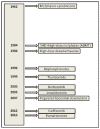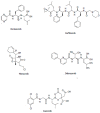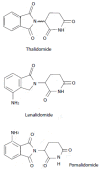Novel agents and new therapeutic approaches for treatment of multiple myeloma
- PMID: 25332907
- PMCID: PMC4202483
- DOI: 10.5662/wjm.v4.i2.73
Novel agents and new therapeutic approaches for treatment of multiple myeloma
Abstract
This review summarizes the therapeutic strategies and the drugs actually in development for the management of myeloma patients. Multiple myeloma is caused by the expansion of monoclonal plasma cells and secretion of M-protein (immunoglobulins, Bence Jones protein and free light chains). Multiple myeloma still remains an incurable disease with a high incidence rate in the elderly, despite the introduction of several new therapeutic agents (bortezomib, lenalidomide and thalidomide) which have changed its natural history. The high heterogeneity of this disease leads to large differences in clinical responses to treatments. Thus, the choice of the best treatment is a difficult issue. However, the introduction of new drugs has made it possible to achieve high response rates and good quality responses with long-term disease control. Interactions between tumor cells and their bone marrow microenvironment play a pivotal role in the development, maintenance, and progression of myeloma, inducing also drug resistance. These knowledges have improved treatment options, leading to the approval of new drugs which not only target the malignant cell itself, but also its microenvironment. These agents are in preclinical/early clinical evaluation and they appear to further improve disease control, but their use is still not approved outside of clinical trials.
Keywords: Immunomodulators; Multiple myeloma; New drugs; Proteasome inhibitors; Target therapy.
Figures



Similar articles
-
Multiple Myeloma: New Insights and Therapeutic Approaches.Hematology Am Soc Hematol Educ Program. 2000:147-165. doi: 10.1182/asheducation-2000.1.147. Hematology Am Soc Hematol Educ Program. 2000. PMID: 11701540
-
Current therapeutic strategy for multiple myeloma.Jpn J Clin Oncol. 2013 Feb;43(2):116-24. doi: 10.1093/jjco/hys215. Epub 2013 Jan 4. Jpn J Clin Oncol. 2013. PMID: 23293370 Review.
-
New treatments for myeloma.Joint Bone Spine. 2010 Jan;77(1):20-6. doi: 10.1016/j.jbspin.2009.10.009. Epub 2009 Dec 23. Joint Bone Spine. 2010. PMID: 20031467 Review.
-
New drugs for myeloma.Oncologist. 2007 Jun;12(6):664-89. doi: 10.1634/theoncologist.12-6-664. Oncologist. 2007. PMID: 17602058 Review.
-
The emerging role of novel therapies for the treatment of relapsed myeloma.J Natl Compr Canc Netw. 2007 Feb;5(2):149-62. doi: 10.6004/jnccn.2007.0015. J Natl Compr Canc Netw. 2007. PMID: 17335684 Review.
Cited by
-
Translational Potential of RNA Derived From Extracellular Vesicles in Multiple Myeloma.Front Oncol. 2021 Aug 27;11:718502. doi: 10.3389/fonc.2021.718502. eCollection 2021. Front Oncol. 2021. PMID: 34513695 Free PMC article. Review.
-
Bortezomib-related neuropathy may mask CNS relapse in multiple myeloma: A call for diligence.Cancer Biol Ther. 2016 Jul 2;17(7):723-6. doi: 10.1080/15384047.2016.1178427. Epub 2016 Apr 22. Cancer Biol Ther. 2016. PMID: 27105248 Free PMC article.
-
HDAC1 promotes the migration of human myeloma cells via regulation of the lncRNA/Slug axis.Int J Mol Med. 2022 Jan;49(1):3. doi: 10.3892/ijmm.2021.5058. Epub 2021 Nov 5. Int J Mol Med. 2022. PMID: 34738621 Free PMC article.
-
Anti-VEGF Drugs in the Treatment of Multiple Myeloma Patients.J Clin Med. 2020 Jun 6;9(6):1765. doi: 10.3390/jcm9061765. J Clin Med. 2020. PMID: 32517267 Free PMC article. Review.
-
Pomalidomide, bortezomib and low-dose dexamethasone in lenalidomide-refractory and proteasome inhibitor-exposed myeloma.Leukemia. 2017 Dec;31(12):2695-2701. doi: 10.1038/leu.2017.173. Epub 2017 Jun 2. Leukemia. 2017. PMID: 28642620 Free PMC article. Clinical Trial.
References
-
- Palumbo A, Anderson K. Multiple myeloma. N Engl J Med. 2011;364:1046–1060. - PubMed
-
- Chanan-Khan AA, Giralt S. Importance of achieving a complete response in multiple myeloma, and the impact of novel agents. J Clin Oncol. 2010;28:2612–2624. - PubMed
-
- Gertz MA, Ansell SM, Dingli D, Dispenzieri A, Buadi FK, Elliott MA, Gastineau DA, Hayman SR, Hogan WJ, Inwards DJ, et al. Autologous stem cell transplant in 716 patients with multiple myeloma: low treatment-related mortality, feasibility of outpatient transplant, and effect of a multidisciplinary quality initiative. Mayo Clin Proc. 2008;83:1131–1138. - PubMed
Publication types
LinkOut - more resources
Full Text Sources
Other Literature Sources

